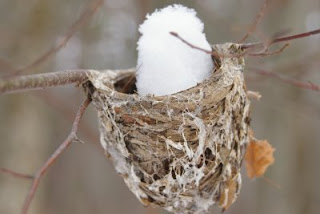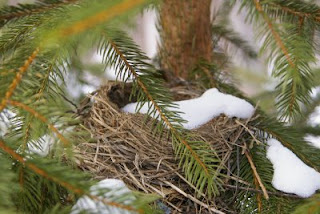
The builders of some of these nests, such as the vireo nest above, deal with winter by avoiding it. We may think of the red-eyed vireo as a local bird, but evolutionarily it is a tropical species that breeds in our temperate forest, probably due at least in part to our abundant insect populations in the summer. The winter vireo lives a very different life in South America - flocking instead of defending territories, eating almost exclusively fruit instead of mostly insects. When the vireos arrive back in late April or May, they may use some bark strips from this nest to construct their new one, but they most likely will not use this nest again.
Most smaller birds don't regularly reuse nests, although large raptor nests may be reused year after year, not always by the builder. Great-horned owls in particular do not build their own structures, so they will occupy anything from a crow nest to a heron nest to a hawk nest. Cavity nests are one form of smaller nest which, being sturdy and safer than stick nests, are sometimes reused. For example, the cavity below may have been excavated by a chickadee, then reused by a titmouse or nuthatch. One of the benefits of observing nests in the summer is that there is a chance to answer such questions as who exactly used this nest or were the birds successful. However, there is the risk that if you continuously visit a nest, even if you don't scare the parents you may lead predators to the nest either by your actions or by the scent trail you leave behind.

Chickadees, titmice, and nuthatches can all easily be found in winter foraging flocks. Another species which is still around but more elusive are American robins. Many migrate farther south, but some take their chance on finding enough food to survive the northern winter. Like vireos, they change their behavior to become birds which wander in flocks and feed mostly on fruit. A couple of weeks ago a flock of robins descended on trees near my office, and I haven't encountered them since.

This nest, still shielded by evergreen needles, is a reminder of when robins were territorial and family-minded. The outside weave appears to be loosening, but the form is intact. Bird nests must be maintained throughout their use. As the winter progresses, wind, snow, and freezing rain take their toll. One robin nest I found had been reduced to just the inner mud cup. So maybe the best time to look at nests is next winter, soon after the leaves have fallen and the birds have transitioned into their winter lives.
(Note - it is illegal to collect bird nests without a permit. This is a good thing because even if someone says they collected the nest in winter, there's no way to verify that that is true.
Besides, nesting material may be reused even if nests are not.)

1 comment:
I love these pictures! Beautiful post.
Post a Comment